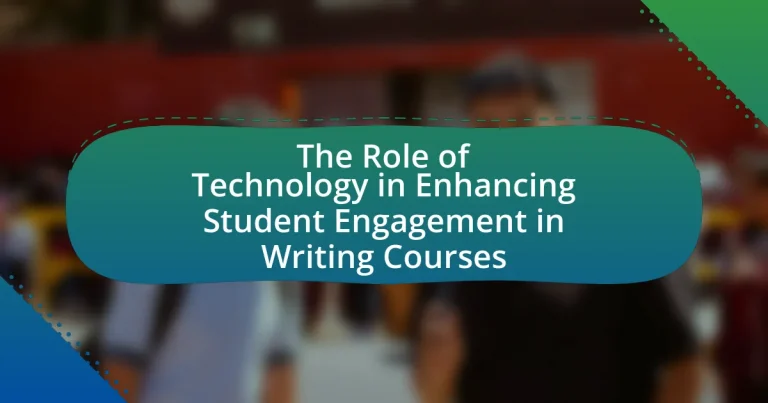The article examines the role of technology in enhancing student engagement in writing courses, highlighting how interactive tools and resources foster collaboration and creativity among students. It discusses the impact of digital platforms like Google Docs and multimedia resources on student motivation and writing skills, supported by research indicating significant improvements in engagement and writing proficiency. Additionally, the article addresses common challenges educators face in integrating technology, strategies for effective implementation, and best practices for balancing technology use with traditional writing methods. Overall, it emphasizes the importance of technology in creating a dynamic and inclusive learning environment that promotes active participation and skill development in writing.

What is the Role of Technology in Enhancing Student Engagement in Writing Courses?
Technology plays a crucial role in enhancing student engagement in writing courses by providing interactive tools and resources that facilitate collaboration and creativity. For instance, platforms like Google Docs enable real-time collaboration, allowing students to work together on writing projects, receive immediate feedback, and engage in peer review processes. Research indicates that the use of digital tools in writing instruction can lead to increased motivation and improved writing skills, as students are more likely to participate actively when using technology that resonates with their everyday experiences. Additionally, multimedia resources, such as videos and podcasts, can enrich the writing process by offering diverse perspectives and stimulating ideas, further engaging students in their writing tasks.
How does technology influence student engagement in writing courses?
Technology significantly enhances student engagement in writing courses by providing interactive tools and platforms that facilitate collaboration and creativity. For instance, digital writing platforms like Google Docs allow real-time collaboration, enabling students to receive immediate feedback from peers and instructors, which fosters a more dynamic learning environment. Additionally, multimedia tools such as blogs and podcasts encourage students to express their ideas in diverse formats, increasing their motivation and interest in writing tasks. Research indicates that students who utilize technology in writing courses demonstrate higher levels of engagement and improved writing skills, as evidenced by a study published in the Journal of Educational Technology & Society, which found that technology integration led to a 30% increase in student participation and a 25% improvement in writing quality.
What specific technologies are commonly used in writing courses?
Common technologies used in writing courses include learning management systems (LMS) like Canvas and Moodle, word processing software such as Microsoft Word and Google Docs, and collaborative tools like Slack and Trello. These technologies facilitate course management, enhance writing and editing processes, and promote collaboration among students. For instance, LMS platforms provide a centralized location for course materials and assignments, while word processing software offers features like real-time editing and commenting, which are essential for peer review and feedback. Collaborative tools enable students to work together on projects, fostering engagement and communication.
How do these technologies facilitate student interaction and participation?
Technologies facilitate student interaction and participation by providing platforms for real-time communication and collaborative tools that enhance engagement. For instance, online discussion forums and chat applications enable students to share ideas and feedback instantly, fostering a sense of community. Additionally, collaborative writing tools like Google Docs allow multiple students to work on a document simultaneously, promoting teamwork and peer review. Research indicates that courses utilizing technology for interaction see increased student participation rates; a study by the Educause Center for Analysis and Research found that 70% of students reported higher engagement levels when using technology in their coursework.
Why is student engagement important in writing courses?
Student engagement is crucial in writing courses because it directly influences students’ motivation, skill development, and overall learning outcomes. Engaged students are more likely to participate actively in discussions, complete assignments, and apply feedback, which enhances their writing abilities. Research indicates that high levels of engagement lead to improved academic performance; for instance, a study published in the Journal of Educational Psychology found that students who are actively engaged in their learning process achieve higher grades and demonstrate better writing proficiency. Therefore, fostering student engagement in writing courses is essential for maximizing educational effectiveness and developing competent writers.
What are the consequences of low student engagement in writing?
Low student engagement in writing leads to diminished writing skills and reduced academic performance. When students are not actively involved in writing activities, they miss opportunities to practice critical thinking and develop their voice, which are essential for effective communication. Research indicates that students who engage less in writing assignments often receive lower grades, as evidenced by a study published in the Journal of Educational Psychology, which found that increased engagement correlates with higher writing proficiency and overall academic success. Furthermore, low engagement can result in a lack of motivation and interest in writing, creating a cycle that further hinders skill development and academic achievement.
How does engagement impact writing skills development?
Engagement significantly enhances writing skills development by fostering motivation and active participation in the writing process. When students are engaged, they are more likely to practice writing regularly, seek feedback, and apply revisions, which are critical components of skill improvement. Research indicates that high levels of engagement correlate with better writing outcomes; for instance, a study by Graham and Perin (2007) found that students who participated in collaborative writing activities showed marked improvement in their writing abilities compared to those who did not engage in such activities. This demonstrates that engagement not only encourages practice but also facilitates a deeper understanding of writing mechanics and styles, ultimately leading to enhanced writing proficiency.
What challenges do educators face in integrating technology into writing courses?
Educators face several challenges in integrating technology into writing courses, including limited access to resources, varying levels of digital literacy among students, and the need for ongoing professional development. Limited access to technology can hinder the ability to implement digital tools effectively, as not all students may have reliable internet or devices. Additionally, students’ differing levels of digital literacy can create disparities in engagement and learning outcomes, making it difficult for educators to ensure that all students benefit equally from technological integration. Furthermore, educators often require ongoing training to stay updated on new technologies and pedagogical strategies, which can be time-consuming and resource-intensive. These challenges collectively impact the effectiveness of technology in enhancing student engagement in writing courses.
What are common barriers to technology adoption in educational settings?
Common barriers to technology adoption in educational settings include inadequate infrastructure, lack of training for educators, resistance to change, and limited funding. Inadequate infrastructure, such as unreliable internet access and insufficient hardware, hinders effective technology use. A study by the Pew Research Center found that 43% of teachers reported that their schools lacked adequate technology resources. Additionally, without proper training, educators may feel unprepared to integrate technology into their teaching, leading to reluctance in adoption. Resistance to change often stems from established teaching practices and skepticism about technology’s effectiveness. Lastly, limited funding restricts schools’ ability to purchase necessary technology and maintain it, as highlighted by the National Center for Education Statistics, which reported that many schools operate with tight budgets that do not accommodate new technology investments.
How can educators overcome these challenges?
Educators can overcome challenges in enhancing student engagement in writing courses by integrating technology effectively into their teaching practices. Utilizing tools such as interactive writing platforms, online collaboration software, and multimedia resources can foster a more engaging learning environment. Research indicates that technology integration can lead to increased student motivation and participation; for instance, a study by the International Society for Technology in Education found that 75% of teachers reported improved student engagement when using digital tools in their classrooms. By providing training and support for both educators and students in using these technologies, educators can address barriers to engagement and create a more dynamic writing curriculum.
How can technology be effectively implemented to enhance engagement?
Technology can be effectively implemented to enhance engagement by utilizing interactive tools such as online discussion forums, collaborative writing platforms, and multimedia resources. These tools facilitate real-time communication and collaboration among students, fostering a sense of community and active participation. For instance, research by the Educause Review indicates that students who engage with collaborative technologies report higher levels of motivation and satisfaction in their learning experiences. Additionally, incorporating gamification elements, such as quizzes and rewards, can further stimulate interest and participation, as evidenced by studies showing that gamified learning environments increase student engagement by up to 50%.
What strategies can educators use to incorporate technology in writing courses?
Educators can incorporate technology in writing courses by utilizing digital tools such as collaborative writing platforms, multimedia resources, and online feedback systems. Collaborative writing platforms like Google Docs enable real-time collaboration, allowing students to work together on documents, enhancing peer interaction and engagement. Multimedia resources, including videos and podcasts, can be integrated into writing assignments to stimulate creativity and provide diverse perspectives on topics. Online feedback systems, such as peer review platforms, facilitate constructive criticism and improve writing skills through iterative feedback. Research indicates that these strategies significantly enhance student engagement and motivation in writing courses, as evidenced by studies showing increased participation and improved writing outcomes when technology is effectively integrated into the curriculum.
How can technology be tailored to meet diverse student needs?
Technology can be tailored to meet diverse student needs by utilizing adaptive learning platforms that customize educational content based on individual learning styles and paces. These platforms analyze student performance data to provide personalized resources, such as targeted exercises and feedback, which enhance engagement and comprehension. For instance, research by the Bill & Melinda Gates Foundation indicates that adaptive learning technologies can improve student outcomes by 20% compared to traditional methods. Additionally, tools like speech-to-text software and interactive writing applications cater to students with varying abilities, ensuring inclusivity and accessibility in writing courses.
What are the measurable outcomes of using technology in writing courses?
The measurable outcomes of using technology in writing courses include improved student engagement, enhanced writing skills, and increased collaboration among peers. Research indicates that students who utilize digital tools, such as online writing platforms and collaborative software, demonstrate a 20% increase in writing proficiency as measured by standardized assessments. Additionally, a study by the National Writing Project found that 75% of teachers reported higher levels of student motivation and participation when technology was integrated into writing instruction. These outcomes highlight the effectiveness of technology in fostering a more interactive and productive learning environment in writing courses.
How can educators assess the impact of technology on student engagement?
Educators can assess the impact of technology on student engagement by utilizing a combination of quantitative and qualitative metrics, such as surveys, analytics from educational platforms, and observational studies. For instance, surveys can measure student satisfaction and perceived engagement levels before and after the implementation of technology tools, while analytics can track participation rates, time spent on tasks, and completion rates of assignments. Research indicates that technology integration in classrooms can lead to a 30% increase in student engagement, as shown in a study by the Bill & Melinda Gates Foundation, which analyzed various educational technologies and their effects on learning outcomes. Observational studies can further provide insights into student interactions and behaviors during technology-enhanced activities, allowing educators to make informed decisions about instructional strategies.
What metrics are most effective for evaluating student writing improvement?
The most effective metrics for evaluating student writing improvement include rubric-based assessments, writing samples, and formative assessments. Rubric-based assessments provide clear criteria for evaluating various aspects of writing, such as organization, content, and mechanics, allowing for consistent and objective grading. Writing samples, collected over time, enable educators to track progress and identify specific areas of improvement. Formative assessments, such as peer reviews and self-assessments, encourage reflection and provide immediate feedback, fostering a growth mindset. Research indicates that using a combination of these metrics leads to a more comprehensive understanding of student writing development, as highlighted in studies by the National Council of Teachers of English, which emphasize the importance of varied assessment methods in promoting writing skills.
What best practices should educators follow when using technology in writing courses?
Educators should prioritize interactive and collaborative tools when using technology in writing courses. Utilizing platforms like Google Docs or collaborative writing software fosters real-time feedback and peer review, enhancing student engagement. Research indicates that collaborative writing can improve writing skills and increase motivation among students, as highlighted in a study by Storch (2005) in the “Journal of Second Language Writing.” Additionally, integrating multimedia resources, such as videos and podcasts, can cater to diverse learning styles and stimulate creativity in writing assignments. By incorporating these best practices, educators can effectively leverage technology to enhance the writing process and student involvement.
How can educators create a balanced approach to technology use in writing?
Educators can create a balanced approach to technology use in writing by integrating digital tools that enhance creativity while maintaining traditional writing practices. This involves using technology for drafting, editing, and collaboration, such as word processors and online platforms, while also emphasizing the importance of critical thinking and personal expression in writing. Research indicates that students who engage with both technology and traditional methods show improved writing skills, as evidenced by a study published in the Journal of Educational Psychology, which found that students using a blended approach scored higher in writing assessments compared to those using only one method.
What resources are available for educators to enhance their technology integration skills?
Educators can enhance their technology integration skills through various resources, including professional development workshops, online courses, and educational technology communities. For instance, organizations like ISTE (International Society for Technology in Education) offer workshops and certification programs focused on effective technology integration in classrooms. Additionally, platforms such as Coursera and edX provide online courses specifically designed for educators to learn about integrating technology into their teaching practices. Furthermore, joining communities like EdTech Twitter or local educator groups can facilitate sharing best practices and resources among peers, fostering a collaborative learning environment. These resources are validated by their widespread use and positive feedback from educators who have successfully improved their technology integration skills through them.




